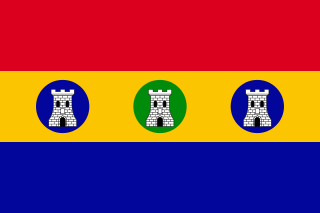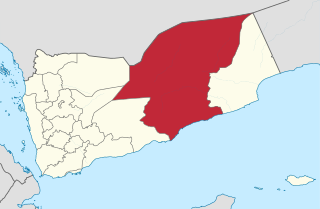
Aden is a port city located in Yemen in the southern part of the Arabian peninsula, positioned near the eastern approach to the Red Sea. It is situated approximately 170 km east of the Bab-el-Mandeb strait and north of the Gulf of Aden. With its strategic location on the coastline, Aden serves as a gateway between the Red Sea and the Arabian Sea, making it a crucial maritime hub connecting Africa, Asia, and the Middle East. As of 2023, Aden City has a population of approximately 1,080,000 residents, making it one of the largest cities in Yemen.

Hadhramaut is a geographic region in South Arabia, comprising eastern Yemen, parts of western Oman and southern Saudi Arabia. The name is of ancient origin, and is retained in the name of the Yemeni Governorate of Hadhramaut. The people of Hadhramaut are called Hadarem. They formerly spoke Hadramautic, an old South Arabian language, but they now predominantly speak Hadhrami Arabic.
The Ziyadid dynasty was a Muslim dynasty that ruled western Yemen from 819 until 1018 from the capital city of Zabid. It was the first dynastic regime to wield power over the Yemeni lowland after the introduction of Islam in about 630.

Mukalla is a seaport and the capital city of Yemen's largest governorate, Hadhramaut. The city is in the southern part of the Arabian Peninsula on the Gulf of Aden, on the shores of the Arabian Sea, about 480 kilometres east of Aden. It is the most important port city in the Hadhramaut region. It is also the sixth-largest city in Yemen, with a population of approximately 595,000 as of 2023. The city is served by the nearby Riyan International Airport.

Qu'aiti, or the Qu'aiti Sultanate of Shihr and Mukalla, was a sultanate in the Hadhramaut region of the southern Arabian Peninsula, in what is now Yemen. Its capital was Mukalla, and it was divided into six provinces including Al-Mukalla, Ash-Shihr, Shibam, Du'an, the Western Province and Hajr. Apart from Al-Mukalla, Ash-Shihr and Shibam were the Sultanate's major cities.

Kathiri, officially the Hadhrami Kathiri Dynasty in Seiyun or the Sultanate of Seiyun, was a sultanate in the Hadhramaut region of the southern Arabian Peninsula, in what is now part of Yemen and the Dhofari region of Oman.

The Mahra Sultanate, known in its later years as the Mahra State of Qishn and Socotra or sometimes the Mahra Sultanate of Ghayda and Socotra was a sultanate that included the historical region of Mahra and the Guardafui Channel island of Socotra in what is now eastern Yemen. It was ruled by the Banu Afrar dynasty for most of its history.

Hadhramaut Governorate is a governorate of Yemen. Lying within the large historical region of Hadhramaut, it is the country's largest governorate.

Al-Shihr, also known as ash-Shir or simply Shihr, is a coastal town in Hadhramaut, eastern Yemen.

The Tahirid Sultanate were an Arab Muslim dynasty that ruled Yemen from 1454 to 1517. They succeeded the Rasulid Dynasty and were themselves replaced by the Mamluks of Egypt after only 63 years in power.
Al-Mansur al-Husayn II was an Imam of Yemen who ruled in 1727–1748. He belonged to the Qasimid family which claimed descent from Muhammad, who dominated the Zaidi imamate of Yemen in 1597–1962.
Al-Mutawakkil Ahmad (26), September 1756 - 10 September 1816 was an Imam of Yemen who ruled in 1809–1816. He belonged to the Qasimid family, descendants of the Islamic prophet Muhammad, which dominated the Zaidi imamate of Yemen from 1597 to 1962.

The Omani Empire was a maritime empire, vying with Portugal and Britain for trade and influence in the Persian Gulf and Indian Ocean. After rising as a regional player in the 18th century, the empire at its peak in the 19th century saw its influence or control extend across the Strait of Hormuz to modern-day Iran and Pakistan, and as far south as Cape Delgado. After the death of Said bin Sultan in 1856 the empire was divided between his sons into two sultanates, an African section ruled by Majid bin Said and an Asian section ruled by Thuwaini bin Said.

The First Battle of Mukalla (2015) was a battle between al-Qaeda in the Arabian Peninsula, local tribesmen, and the Yemen Army for control of the coastal city of Mukalla, Yemen.
The Hadramaut insurgency was an insurgency in Yemen launched by AQAP and ISIL-YP against forces loyal to president Abdrabbuh Mansur Hadi.
The 2019–20 Saudi Professional League was the 44th edition of the Saudi Professional League, the top Saudi professional league for association football clubs, since its establishment in 1976. The season started on 22 August 2019 and concluded on 9 September 2020.
Badr bin Sultan bin Abdulaziz Al Saud is a member of the House of Saud. He was former governor of Al Jawf Region and former the deputy governor of Mecca Province.

The battle of al-Shihr was a military confrontation in 1548 between the Portuguese alongside Sa'd bin Afrar, the ruler of Mahra Sultanate and Kathiri Sultanate who had captured al-Mahrah from Sa'd The Portuguese successfully captured the fort near al-Shihr from the Kathiris.
Alaa el-Din Ali bin el-Emam, commonly known as Alaa el-Din bin el-Emam and nicknamed Abu el-ostool, was an Egyptian prince from the Egyptian el-Emam family. He is the descendant of the Sheikh of Islam, the Egyptian judge Abu Uday el-Masry bin el-Emam. He rose through the political ladder during the era of the Egyptian Sultan Al-Ashraf Qansuh al-Ghuri, until he was appointed to the highest positions in the Egyptian Sultanate. He was one of the most powerful figures in the era of the Egyptian Sultanate. He held the positions of Amir al-Hajj, supervisor of Special, supervisor of Endowments, Secret writer and supervisor of the Egyptian armies.
Nasir el-Din Shafi’ bin Ali bin Abbas el-Kinani el-Asqalani el-Masry, commonly known as Shafi' bin Ali el-Masry was an Egyptian writer, historian, biographer, poet and military commander who participated in the conquests of the Egyptian army during the era of Sultan El-Mansur Seif el-Din Qalawun.













